
Dazzle Patterns and running shoes
How does a novel take shape? Well, a writer starts with a germ of a story and goes from there. The author then refines and repeats the process over and over until it is finally published. Kind of like running or race preparation. How else do you get to the end result? Right? Although this is not a running story per se, it is a story about my friendship with a writer who also happens to be a runner.
During the course of writing her novel Dazzle Patterns, Alison Watt, and I ran together many times over many kilometres. She would write sections of the story and then when we ran she would tell them to me. Once upon a time, the story started with her grandfather drifting around the ocean in a life-raft with a dozen other men. A few runs later, I’d ask how the writing was going or I’d ask how a particular character was developing and BAM! that character would be gone: written off, dropped on the novelist’s floor. Or sometimes the plot would have taken a completely different direction. Or the setting had moved from one coast of the country to the other. It was always fun to hear the latest iteration of the story.
All the while we ran and we laughed, got fitter, and in retrospect, I think this helped Alison develop the story. Novel writing is a solitary occupation, requiring the author to labour in front of a computer screen, on a typewriter or pushing a pen over paper for many hours. They put their thoughts down and mull them over, but once in a while they need to share them; to say them out loud, to get them out of their head, and to see how they fly in the world. I’m not sure how I helped in this process with Alison during our runs except to provide a willing ear and ask a question here and there. Although I have to say the version of the narrative during those early runs did not bear much resemblance to the final published novel. Let’s just say that it is a process, but I do hope that she revisits those early stories someday.
Nova Scotia
Jumping ahead a few years after Alison, completed an MFA in Creative Writing, refined the novel, and morphed into its final published form, we covered many kilometres together and yes, shared many glasses of wine! While unable to attend the first book launch on our west coast home island, I decided to join her for the launch of the book in Halifax, Nova Scotia. Quite the leap, eh, but I had just finished my track season, completed the final race in the trail series, and ran my last road race of the year. In other words, it was racing downtime and definitely time for a recovery break! Plus it was a perfect time to visit my son in Labrador. Combining all of this, I thought, would make an excellent vacation!

Planking on the big guns at the Halifax Citadel
I arrived in Halifax in late October 2017, the day before Alison, and spent a day recovering from the cross-Canada overnight travels. Of course, I went for a run after checking into my AirBnB, having a wonderful cup of coffee at the Dilly Dally Cafe, and having a nap. I covered a lot of ground running that day, in a most unseasonal, but glorious summer-like day. I scooted past and marveled at the Emera outdoor skating oval (brilliant idea for all seasons!), reacquainted myself with the Halifax Citadel, and checked out several Haligonian neighbourhoods I’d never seen before.
Maritime Museum visit
Upon meeting up with Alison the next day, near our fabulous and historic accommodation at the Waverley Inn, we struck out for a walk, with the Maritime Museum of the Atlantic as our first destination. This museum has the most amazing collection of artifacts, images, and stories about the 1917 Halifax Explosion and the sinking of the Titanic in 1912 (including the role Halifax played in that disaster).
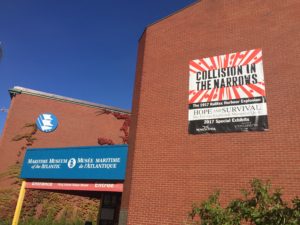 Visiting the museum before Alison’s book talk was the perfect refresher course for both of us on Halifax history. With amazing luck, we managed to tag onto a museum tour through both these collections. Our tour guide was fabulous! We asked lots of questions and he seemed to have an answer and a story for them all. The large black and white images covering the exhibit walls showing the destruction from the explosion were mesmerizing.
Visiting the museum before Alison’s book talk was the perfect refresher course for both of us on Halifax history. With amazing luck, we managed to tag onto a museum tour through both these collections. Our tour guide was fabulous! We asked lots of questions and he seemed to have an answer and a story for them all. The large black and white images covering the exhibit walls showing the destruction from the explosion were mesmerizing.
Equally intriguing, were the exhibits of the linen mortuary bags (containing buttons, pins, baby shoes, etc.) that were displayed in both the Halifax Explosion and the Titanic exhibits. Amazingly there was a father/son connection between these bags and these two disasters. One of Alison’s main characters, Fred, finds himself learning how to process the bodies from the real-life Arthur Barnstead, the Registrar of Deaths for Halifax, during the Halifax Explosion and son of Dr. John Henry Barnstead, a Halifax physician, during the Titanic disaster.
Oh, the book…
Here is where I should give you a quick precis of Alison’s novel, Dazzle Patterns, as you may wonder what the heck a west coast author is doing giving a book reading in Halifax. Well, the book starts with the 1917 Halifax Explosion and you meet Clare, a glass flaw inspector; Fred, a glass blower; and Leo, Clare’s fiancé, who has just gone off to fight in WW1. We follow these three characters around Halifax, through their lives, touching on the fine art of glass blowing, painting, and dealing with death and destruction from both the explosion and WW1.
Suffice it to say, I loved the book! And I can proudly say that the book was a finalist for the 2018 Amazon Canada First Novel Award, a 49th Shelf Top Fiction Book of 2017, as well as a finalist for the 2018 Alberta Trade Fiction Book of the Year Award. Well, done, my friend! Thankfully, Freehand Books, the book’s publisher, recognized the significance of launching the book in Halifax during the time of the many 100th-year commemoration ceremonies of the 1917 Halifax Explosion.
“Suffice it to say, I loved the book!”
Tour of Halifax
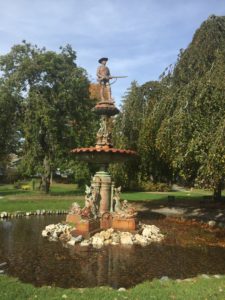
Soldier’s Boer War Memorial Fountain in the Halifax Public Gardens
Outside the museum, we visited many sites (both walking or while running), some of which were significant in Alison’s story, including the Halifax Public Gardens, where Leo and Clare visited just before Leo shipped out to Europe.
“For a time they sat by the fountain. Then Clare rose and took him by the hand. She led him into the farthest corner of the garden, wandering, unspeaking, past the irises and peonies, the clipped privets, under the beeches, past the lake, to a thicket of lilacs. Leo took off his uniform jacket and laid it on the uncut grass.”
We also sat by several of the fountains and wandered through the garden speculating (spoiler alert) just where were Clare and Leo intimate and where did Leo propose to Clare in this garden?
Although not significant to the story, we decided to slip into the magnificent central branch of the Halifax Public Library for a quick tour. It seemed to be the perfect venue to indulge my librarian background and Alison’s author and artist talents. It is truly amazing and so worth a visit if only to admire the architecture and the public art installations (especially the works of Cliff Eyland).
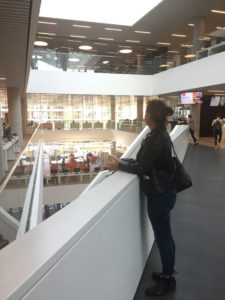
Alison Watt in the Halifax Public Library
One evening, we strolled along Argyle Street, through one of Halifax’s historic neighbourhoods, near St Paul’s Anglican Church, the oldest building in Halifax, built in 1750, the year after Halifax was founded. Across the street was the site of the Victoria School of Art and Design (a precursor to the Nova Scotia College of Art and Design and now in a different location).
The school which at the time of the Halifax Explosion was directed by Arthur Lismer. He went on to become one of the founding members of the Group of Seven and as a character in Alison’s book, he encourages both Clare and Fred to take art classes at the school. Lismer lived in Dartmouth, across the harbour from Halifax, and created many sketches and paintings of the WW1 warships, including ones painted in dazzle patterns, as well as the wreckage following the explosion.
The original art school site, at 1740 Argyle Street, is now the Five Fishermen Restaurant, where we enjoyed a delicious seafood meal and chatted with the manager about this famous site. Between its original art school and restaurant incarnations, the building actually housed a mortuary run by Snow and Sons, which would go on to become J.A. Snow Funeral Home. And sadly, this was where many of the victims from both the Titanic and the Halifax Explosion were given funerals.
Another major site that featured in Alison’s book and was key in the aftermath of the explosion, was the Chebucto School. It was relatively unscathed in the explosion, being some distance from the epicentre and was used as a triage and first aid centre, morgue, and later funeral home. Fred, being of able body and without his job as a glass blower, volunteered to help in the morgue at this large 20th century Classical Revival style brick building.
“They took the bodies to the school. It stood dark and impassive, its two solid storeys facing the snowstorm. Fred Baker, the cadet and the soldier carried the heaviness of death down the stairs of the dark school, into the basement, which had become the morgue.”
Although Alison and I didn’t visit this site during our visit together, I’m pretty sure I passed this building as I rode a city bus through Halifax. This dominant building still stands and currently houses the Maritime Conservatory of Performing Arts.

Inside the grounds of the Halifax Citadel
Of course, Alison and I ran while we were in Halifax and since we were so close to the Halifax Citadel, I suggested we run there. The view from the appropriately situated site is fabulous in all directions. Apparently, the hundreds of soldiers stationed there at the time of the explosion were an enormous help during the aftermath of the explosion.
While Alison worked on book promotions, I did a solo run around the historic Point Pleasant at the entrance to Halifax Harbour. While there, I thought of the book’s character, Leo. He would have passed this way when he shipped out for foreign shores during WW1. Were he looking off the ship’s starboard side, he would have seen a treed area scattered with military armaments or fortifications from past battles. During the Halifax Explosion, despite the distance from the explosion epicentre, all the trees on the point were apparently flattened. I can happily report that they have long since recovered, despite a setback from Hurricane Juan in 2003.
Reading amongst history

Alison Watt signing a copy of Dazzle Patterns with Peter Dykhuis and Alan Ruffman
Quite wonderfully from a writer and an artist’s perspective, Alison read from her book amongst many Lismer paintings and sketches at the Dalhousie Art Gallery. These provided a fabulous backdrop for her story and we were able to meet with some exceptional Lismer scholars that evening, including Alan Ruffman and Peter Dykhuis. I should also note that Alison is a fantastic artist in her own right and this shows in her wonderfully descriptive prose.
Wolfville and family history

Running through fall colours in the Harriet Irving Botanical Gardens, Wolfville, NS
Following our time in Halifax, we headed over to Wolfville on the western side of Nova Scotia. There we walked and ran some more and visited sites such as Acadia University (in particular the Harriet Irving Botanical Gardens) and the Grand Pré National Historic Site.
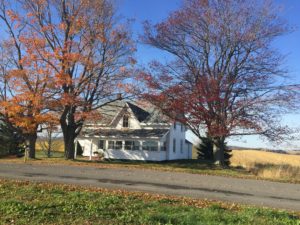
Alison Watt’s grandmother’s family home near Grand Pré
The main purpose of the visit to this side of the Nova Scotian peninsula was to trace Alison’s maternal family roots. And, perhaps not so coincidentally, this was also the farming area where the book’s characters, Leo and Clare hailed from. While there we visited Alison’s grandmother’s childhood home. This is where Grandma Roxy lived before she headed to Halifax to fill one of the many empty jobs following the Halifax Explosion. There she met Alison’s grandfather and, in a sense, this whole Dazzle Patterns story was born.
The journey continues…
While in Wolfville, we stayed at the historic Blomidon Inn, visited with Acadia student and friend, Ashlee Jansen, and lucked into a fabulous annual event called Devour, the Food Film Fest, in which we fully participated! Did I mention that in addition to running, we both like food, wine, and movies? And OMG the Bubbly Bus tour was so much fun! But I think all that might be another story!
Here’s a toast to our running, laughing, eating, traveling, drinking and friendship adventures together. May they go on and on!

Bubbly wine and food pairing at L’Acadie Vineyards
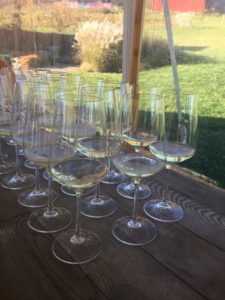
Sampling bubbly wine at Benjamin Bridge Winery


Splendid commentary on the trip and the book, the friendship and the path of the novel.
Thanks Mary Jo. I appreciate your comment. Maybe the three of us should have an adventure together soon!
OMG!!! what a fabulous post–I relived it all (including those runs of long ago when I was wrestling with plot!). What a great friend you have been (are) running and non-running-wise. Gotta get out running again soon–boy-oh-boy am I excited about my new novel in gestation.
Alison, I’m glad you liked my story about our Nova Scotian adventure together. It was fun recollecting all the happy times we had there.